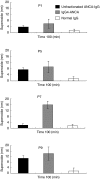Anti-neutrophil cytoplasm antibody IgG subclasses in Wegener's granulomatosis: a possible pathogenic role for the IgG4 subclass
- PMID: 15373923
- PMCID: PMC1809192
- DOI: 10.1111/j.1365-2249.2004.02566.x
Anti-neutrophil cytoplasm antibody IgG subclasses in Wegener's granulomatosis: a possible pathogenic role for the IgG4 subclass
Abstract
A characteristic feature of Wegener's granulomatosis is the presence of antineutrophil cytoplasm antibodies (ANCA) to proteinase 3 (PR3). In vitro, ANCA activate neutrophils by co-ligating PR3 and FcgammaRIIa/IIIb receptors. ANCA are predominantly of the IgG isotype, and IgG1, IgG3 and IgG4 subclasses are particularly represented. To address the pathogenic role of individual ANCA-IgG subclass antibodies, patients' sera were screened using indirect immunofluorescence, enzyme-linked immunosorbent assay (ELISA) and subclass PR3-ELISA to identify patients with high titres of PR3-ANCA within the IgG1, IgG3 or IgG4 subclasses. Unfractionated ANCA-IgG and subclass fractions were isolated by affinity chromatography and compared for their capacities to stimulate superoxide production by primed human neutrophils. Donor neutrophils were analysed for constitutive and induced FcgammaRI expression by flow cytometry. The IgG1, IgG3 and IgG4 subclass fractions, isolated from three different ANCA sera, each stimulated superoxide production from neutrophils derived from multiple donors. Subsequently, IgG4 subclass fractions isolated from a further four ANCA positive sera demonstrated varying abilities to stimulate release of superoxide; unrelated to PR3-ANCA titre, neutrophil donor, or neutrophil FcgammaRI expression. The stimulation of superoxide release by IgG1- and IgG3-ANCA subclass fractions is consistent with the proposed mechanism of co-ligation of PR3 antigen and FcgammaRIIa/IIIb receptors. However, the demonstration of similar activity for the IgG4-ANCA subclass fractions isolated from some sera was unexpected. This activity was independent of neutrophil donor and expression of FcgammaRI, suggesting it was capable of activating neutrophils via constitutively expressed FcgammaRIIa/IIIb or co-ligation of other, unidentified, cell surface molecules.
Figures




Similar articles
-
IgG from myeloperoxidase-antineutrophil cytoplasmic antibody-positive patients stimulates greater activation of primed neutrophils than IgG from proteinase 3-antineutrophil cytosplasmic antibody-positive patients.Arthritis Rheum. 2001 Apr;44(4):921-30. doi: 10.1002/1529-0131(200104)44:4<921::AID-ANR149>3.0.CO;2-4. Arthritis Rheum. 2001. PMID: 11315931
-
IgG subclass distribution, affinity of anti-myeloperoxidase antibodies in sera from patients with Wegener's granulomatosis and microscopic polyangiitis.Nephrology (Carlton). 2008 Oct;13(7):629-35. doi: 10.1111/j.1440-1797.2008.00976.x. Epub 2008 Sep 3. Nephrology (Carlton). 2008. PMID: 18775059
-
Chimeric antibodies to proteinase 3 of IgG1 and IgG3 subclasses induce different magnitudes of functional responses in neutrophils.Ann Rheum Dis. 2007 May;66(5):676-82. doi: 10.1136/ard.2006.061374. Epub 2007 Jan 4. Ann Rheum Dis. 2007. PMID: 17204568 Free PMC article.
-
'Classic' anti-neutrophil cytoplasmic autoantibodies (cANCA), 'Wegener's autoantigen' and their immunopathogenic role in Wegener's granulomatosis.J Autoimmun. 1993 Apr;6(2):171-84. doi: 10.1006/jaut.1993.1015. J Autoimmun. 1993. PMID: 8388690 Review.
-
Pathogenesis of PR3-ANCA associated vasculitis.J Autoimmun. 2008 Feb-Mar;30(1-2):29-36. doi: 10.1016/j.jaut.2007.11.005. Epub 2007 Dec 26. J Autoimmun. 2008. PMID: 18162369 Review.
Cited by
-
The Role of IgG4 in Autoimmunity and Rheumatic Diseases.Front Immunol. 2022 Jan 25;12:787422. doi: 10.3389/fimmu.2021.787422. eCollection 2021. Front Immunol. 2022. PMID: 35145508 Free PMC article. Review.
-
Wegener's granulomatosis: a model of auto-antibodies in mucosal autoimmunity.Clin Immunol. 2010 Feb;134(2):104-12. doi: 10.1016/j.clim.2009.04.014. Epub 2009 May 23. Clin Immunol. 2010. PMID: 19482554 Free PMC article. Review.
-
A diagnostic pitfall in IgG4-related hypophysitis: infiltration of IgG4-positive cells in the pituitary of granulomatosis with polyangiitis.Pituitary. 2015 Oct;18(5):722-30. doi: 10.1007/s11102-015-0650-9. Pituitary. 2015. PMID: 25822111
-
Epitope analysis of anti-myeloperoxidase antibodies in patients with ANCA-associated vasculitis.PLoS One. 2013;8(4):e60530. doi: 10.1371/journal.pone.0060530. Epub 2013 Apr 5. PLoS One. 2013. PMID: 23577119 Free PMC article.
-
Pathogenicity of Proteinase 3-Anti-Neutrophil Cytoplasmic Antibody in Granulomatosis With Polyangiitis: Implications as Biomarker and Future Therapies.Front Immunol. 2021 Feb 18;12:571933. doi: 10.3389/fimmu.2021.571933. eCollection 2021. Front Immunol. 2021. PMID: 33679731 Free PMC article. Review.
References
-
- Savage COS. Nephrology forum. ANCA-related renal disease. Kidney Int. 2001;60:1614–27. - PubMed
-
- Boomsma MM, Stegeman CA, van der Leij M, et al. Prediction of relapses in Wegener's granulomatosis by measurement of antineutrophil cytoplasmic antibody levels: a prospective study. Arthritis Rheum. 2000;43:2025–33. - PubMed
-
- Jayne DR, Gaskin G, Pusey CD, Lockwood CM. ANCA and predicting relapse in systemic vasculitis. Q J Med. 1995;88:127–33. - PubMed
-
- Gaskin G, Pusey CD. Plasmapheresis in antineutrophil cytoplasmic antibody-associated systemic vasculitis. Ther Apher. 2001;5:176–81. - PubMed
-
- Kettritz R, Jennette JC, Falk RJ. Crosslinking of ANCA antigens stimulates superoxide release by human neutrophils. J Am Soc Nephrol. 1997;8:386–94. - PubMed
Publication types
MeSH terms
Substances
LinkOut - more resources
Full Text Sources
Medical

